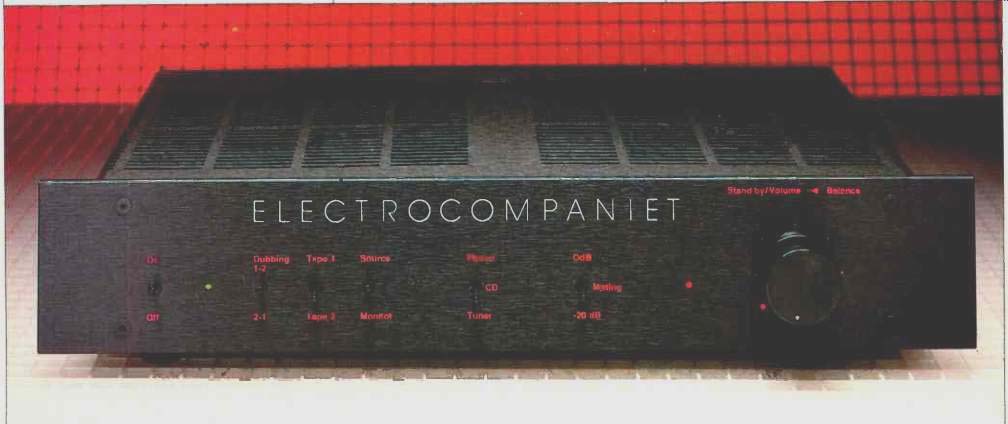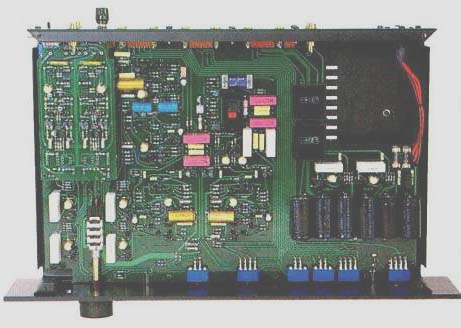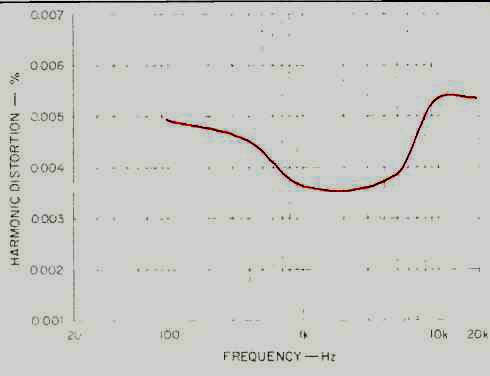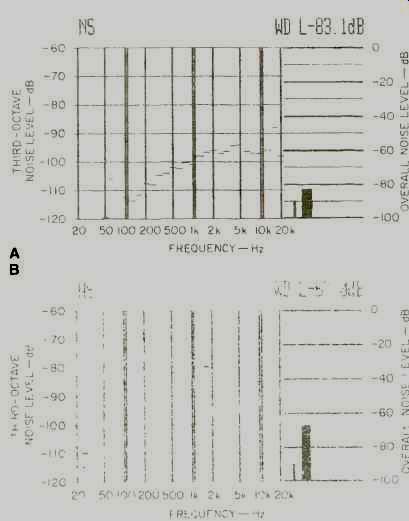
Manufacturer's Specifications:
Gain at 1 kHz: MM phono, 36 dB; MC phono, 56 dB; CD, 20 dB.
THD at 1 kHz for 5 V Output: Phono, less than 0.0025%; CD. less than 0.003%
Overload at 1 kHz for 0.2% THD: MM phono, more than 200 mV; MC phono, more than 25 mV; CD, more than 10 V.
Channel Separation at 1 kHz: Phono, greater than 80 dB; CD, greater than 80 dB; tuner, greater than 90 dB.
S/N: Phono, less than 80 dB, A-weighted, re: 0.5 mV.
Equivalent Input Noise: Phono, 0.2 µV; CD, 3µV; tuner, 0.4 µV.
RIAA Accuracy: ±0.1 dB, 20 Hz to 20 kHz.
Overall Loop Feedback: Phono, 20 dB; line, 20 dB.
Maximum Output for 0.2% THD:
More than 16 V.
Dimensions: 17.3 in. W x 3.5 in. H x 10.4 in. D (43.9 cm x 8.9 cm x 26.4 cm).
Weight: 13.2 lbs. (6 kg).
Price: $1,995.
Company Address: c/o Mel Schilling, Music & Sound Imports, 30 Snowflake Rd., Huntingdon Valley, Pa. 19006.
The maker of this simple but elegant preamplifier, the Norwegian firm of Electrocompaniet, was founded in 1974. Originally, its purpose was to produce amplifiers based upon a design developed by Dr. Matti Otala, a well-known Finnish audio engineer and theoretician. Since then, the company's line has broadened to include audio amplification equipment that handles signals ranging from a few microvolts in amplitude to several hundred watts of power.
Much of the four-page owner's manual that accompanies the EC-1 is devoted to explaining the design philosophy behind the preamplifier. The designers conducted listening tests and concluded that conventional distortion, of the nonlinear type that occurs in the transfer function with respect to time, correlates closely with audible imperfections in amplifier performance. As we all know, one way to reduce measured distortion is to increase negative feedback, but the designers' listening tests showed that this was not the way to improve audible performance. They concluded that while negative feedback might reduce one obvious form of distortion, it can and does affect other important parameters. On the other hand, they found that amplifiers or preamplifiers completely devoid of negative feedback are also audibly deficient.

This dilemma was solved by Electrocompaniet in an un usual (though not totally original) way. Feedback is applied only locally, around individual stages, thus avoiding overall feedback from output to input stage. This concept, according to the designers, was further expanded to take care of phase and interface distortion between the EC-1's stages.
The designers applied loop feedback around only those stages where such feedback resulted in audible improvements. Stability margins were also widened, since feedback no longer affected overall frequency response.
The RIAA equalization function is accomplished by a two-stage, all-passive network, using 1% metal film resistors and 1% polypropylene film capacitors. High-frequency roll-off components for the playback curve are placed as close as possible to the cartridge input to achieve a higher overload margin at the treble end of the spectrum. Low-frequency boost is handled by the second stage to achieve a better signal-to-noise ratio and improved overload characteristics at low frequencies.
All stages incorporate cascode circuitry, which helps to linearize the preamplifier at high frequencies. The power supply has separate regulators, with extended open-loop frequency response, for each stage and channel. The EC-1 I tested came with its power transformer in a separate cylindrical housing that was connected to the preamp by a cable about 40 inches long. This arrangement was to en sure that any hum fields generated by the transformer would have little effect on the preamplifier's audio circuits. The most recent version, the importer tells me, uses a special low-hum transformer mounted inside the unit.
Cartridge matching for moving-coil cartridges is handled by two resistors in each channel. To match the impedance of a given cartridge, you select one of four values for R1 from the seven pairs of precision resistors supplied, and insert it into a socket on the p.c. board (no soldering is required). Then you select one of three values for R2 to adjust gain to match the cartridge's impedance. (The lower the impedance of a moving-coil cartridge, the lower its output is likely to be.) The EC-1 comes with two pairs of resistors already mounted on the p.c. board and five more pairs in transparent bags that are stapled to the owner's manual. A diagram of the moving-coil pre-preamplifier stage is also supplied, showing the location of R1 and R2.
Control Layout
The only rotary controls on the face of the EC-1 are the concentrically mounted volume and balance knobs at the extreme right. When the volume control is rotated fully counterclockwise, much of the circuitry is turned off, but some critical circuits remain operative and ready for use without any warm-up time (assuming the power toggle switch at the left of the panel is switched on). A tiny red light near the volume control indicates that the preamp is in standby mode.
As you might guess, there are no tone-control circuits in the EC-1. All remaining controls are two- or three-position toggle switches. Included are a tape "Dubbing" switch (tape 1 to 2 or tape 2 to 1), a "Tape 1/Tape 2" selector switch, a "Source/Monitor" switch, an input selector switch (phono, tuner, or CD), and a three-position switch that selects full (0-dB) gain.-20 dB gain, or audio muting. The latter position cuts off output altogether: the 0 and- 20 dB switch positions give a choice of normal gain settings so the user can pick the one that allows use of the main volume control's most linear region when listening at low levels.
The rear panel of the EC-1 is equipped with neatly arranged rows of gold-plated input and output jack pairs. The MM/MC selector switch is a toggle at the far left, adjacent to the phono input jacks. Just to the other side of these jacks is the ground terminal. The socket for the long power-trans former cord that was needed for the version I tested is at the right end of the rear panel, as far removed from the phono input stage as possible.
Measurements Input sensitivity for the high-level inputs, referred to 0.5 V output, was 35 mV. The moving-magnet phono inputs required 0.83 mV for the same level of output. The moving-coil inputs required 80 µV of input to reach 0.5 V output with the volume control turned up fully-that is, once I had selected the proper values of R1 and R2 for the relatively high source impedance of my signal generator. (The resistors that were in place when I received the unit had been selected for the lower impedances typical of MC cartridges: with those resistors, I needed 0.4 mV from my generator to attain full output.) Figure 1 shows how THD varied as a function of frequency for an output of 1 V, with overall gain via the high-level inputs set for approximately 10 dB. Considering the fact that there is no overall loop feedback in this preamplifier, the THD levels are quite remarkable-only 0.0037% at 1 kHz, for example! SMPTE-IM distortion for the same test conditions measured only 0.0067%. Maximum output obtainable from the preamp via the high-level inputs was 16.0 V before significant levels of distortion were evident. Phono input overload for the MM inputs measured 300 mV; for the MC inputs it measured close to 30 mV.

Fig. 1--THD vs. frequency, high-level inputs.

Fig. 2--S N analysis. A-weighted, for moving-magnet (A) and moving-coil
(B) phono inputs.
Perhaps the most impressive thing about this preamplifier is its moving-magnet phono signal-to-noise ratio. I measured S/N of 83 dB for a 5-mV input signal with the volume control set for an output of 0.5 V. When you consider the fact that the high-level input S/N measured 86 dB referred to 0.5 V input and unity gain, the result for the MM phono section is truly superb, among the best I have ever obtained for any preamplifier's phono stage. Figure 2A is an analysis of the MM phono S/N characteristics. Figure 2B shows the distribution of noise relative to 0.5 V output for the moving-coil phono inputs, with 0.5 mV of signal applied and the master volume control adjusted to provide the reference output. The RIAA equalization was accurate to within 0.15 dB.
One characteristic of a precision preamplifier/control unit that I feel is extremely important (but which is seldom measured) is volume-control tracking. Once the balance control is set for equal output from both channels with the volume control set at its maximum position, balance should be maintained for a wide range of volume settings. In this regard, the EC-1 performed extremely well. I could not measure more than 0.2 dB of channel imbalance at any setting of the volume control from maximum to-60 dB.
Use and Listening Tests
I tried to select truly superb source material for my listening tests of this very expensive preamplifier. Aware that incremental improvements in sound quality as a function of price are asymptotic, I certainly didn't want any deficiencies in the source material to mask whatever minimal superiority I might hear from a preamp in this price class. (While I am not of the school that maintains that there is no difference in the sound of reasonably designed amplifiers and preamplifiers, neither do I expect to detect gross audible differences.) The setup for these listening tests consisted of the preamplifier itself, a Forté Audio Model 1 power amplifier, a newly acquired Sony DTC-1000ES DAT recorder, and my reference CD player. Initially, the monitor loudspeakers used were KEF 105.2 units, which have long been standard fixtures in my listening room. Later, I substituted a pair of B & W Model 300 speakers, which have served as standbys when I want to judge components using somewhat less costly transducer systems. Finally, I used the same electronics but switched to a newly acquired pair of DCM Model 250 Time Windows, which are bipolar speaker systems.
CDs used in my tests included a Denon recording of Mozart's "Clarinet Quintet in A Major" (28C37-40, Japanese import) and several tracks from Telarc's latest sampler (Volume 4, CD-80004). Although stereo imaging and overall tonal response varied from one speaker system to the next (no great surprise), at least one characteristic was consistent regardless of the speakers used. That characteristic was an openness of sound, a lack of restricted or strained quality, which clearly distinguished the EC-1 preamplifier from lesser models.
I used the DAT machine to record live speech (my own voice and my wife's); in playback, the system described above reproduced the voice recordings with a clarity that surprised this home recording hobbyist.
The LPs used were fairly old but reliable discs (I haven't purchased an LP in some time now, for reasons known to all of us). A few of my favorites, Mobile Fidelity's Original Master recording of Holst's "The Planets" (MFSL 1-510) and Telarc's recording of Saint-Satins' Symphony No. 3, the "Organ Symphony" (10051), seemed to have new sparkle and a sheen that I had not noticed previously. It's logically hard to attribute the improvement merely to the presence of the EC-1 in the signal path, but that may well have been the reason.
It is difficult to justify a price of nearly $2,000 for any preamplifier these days, especially since there are preamps and even integrated amplifiers whose sound quality might be indistinguishable from that of the Electrocompaniet EC-1 for most listeners, and barely distinguishable for a few keen-
eared listeners. But, as we all know, to that keen-eared few, any audible improvement seems to be worth paying for, regardless of how much that improvement costs.
-Leonard Feldman
(adapted from Audio magazine, Nov. 1987)
Also see:
Harman/Kardon Citation Twenty-Five Preamp (Equip. Profile, Mar. 1989)
First Sound Reference II Passive Preamp (Jan. 1992)
= = = =